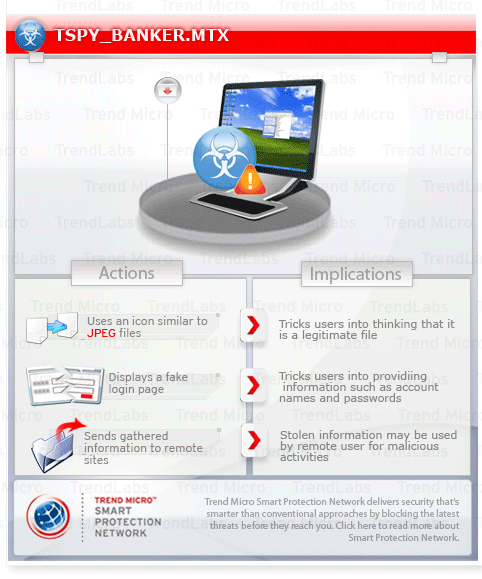TSPY_BANKER.MTX
Windows 98, ME, NT, 2000, XP, Server 2003


Threat Type: Spyware
Destructiveness: No
Encrypted:
In the wild: Yes
OVERVIEW
This spyware uses social engineering methods to lure users into performing certain actions that may, directly or indirectly, cause malicious routines to be performed. Specifically, it comes from spam mails with file attachments purporting to be image (JPEG) files.
To get a one-glance comprehensive view of the behavior of this Spyware, refer to the Threat Diagram shown below.

This spyware arrives as an attachment to email messages spammed by other malware/grayware or malicious users. It may be downloaded by other malware/grayware/spyware from remote sites. It may be unknowingly downloaded by a user while visiting malicious websites.
It uses a file name similar to a legitimate file to pass as a legitimate file.
It attempts to steal sensitive online banking information, such as user names and passwords. This routine risks the exposure of the user's account information, which may then lead to the unauthorized use of the stolen data. It attempts to steal information, such as user names and passwords, used when logging into certain banking or finance-related websites.
TECHNICAL DETAILS
Arrival Details
This spyware arrives as an attachment to email messages spammed by other malware/grayware or malicious users.
It may be downloaded by other malware/grayware/spyware from remote sites.
It may be unknowingly downloaded by a user while visiting malicious websites.
Installation
This spyware drops the following non-malicious file:
- %Windows%\reg_0001.txt
(Note: %Windows% is the Windows folder, which is usually C:\Windows or C:\WINNT.)
It uses a file name similar to a legitimate file to pass as a legitimate file.
Autostart Technique
This spyware adds the following registry entries to enable its automatic execution at every system startup:
HKEY_CURRENT_USER\Software\Microsoft\
Winodws\CurrentVersion\Run
{spyware name} = {Spyware path and file name}
Download Routine
This spyware accesses the following websites to download files:
- http://{BLOCKED}bcomunicaobr.com/system/configs.txt
- http://www.{BLOCKED}gbijoux.com.br/includes/languages/portugues/modules/payment/configs.txt
- http://www.{BLOCKED}cleodecidadania.org/chat/configs.txt
Information Theft
This spyware monitors the Internet Explorer (IE) activities of the affected system, specifically the address bar. It recreates a legitimate website with a spoofed login page if a user visits banking sites with the following strings in the address bar and/or title bar:
- http://www.banrisul.com.br/
- http://www.bradesco.com.br/
- http://www.bradescopessoajuridica.com.br/
- https://bradesconetempresa.com.br/ne/neFrameMaster.asp?CONTROLE=
- https://bradesconetempresa.com.br/scripts/office.dll/
- DISPOSITIVO2/VERIFICADISPOSITIVO
- https://netbanking2.banespa.com.br/default.asp?txtAgencia=
- https://www.santandernet.com.br/default.asp?txtAgencia=
- https://www2.bancobrasil.com.br/aapf/login.jsp?aapf.IDH=sim
- https://wwwss.bradesco.com.br/scripts/ib2k1.dll/LOGIN?AGN=
The spoofed login overlaps the legitimate login area of the website, thus tricking the user into thinking that it is part of the IE window. The spoofed login page is located in a fixed area of the legitimate website. The said routine tricks the user into giving out sensitive account-related information. It then logs keystrokes entered by the user in the user name and password fields of the spoofed login page.
It attempts to steal sensitive online banking information, such as user names and passwords. This routine risks the exposure of the user's account information, which may then lead to the unauthorized use of the stolen data.
It attempts to steal information from the following banks and/or other financial institutions:
- Portal Internet Banrisul
- Bradesco
- Banco Bradesco S/A
- Internet Banking
- Santander
- Banco Brasil
Stolen Information
This spyware saves the stolen information in the following file:
- %Windows%\reg_0001.txt
(Note: %Windows% is the Windows folder, which is usually C:\Windows or C:\WINNT.)
It sends the gathered information via HTTP POST to the following URL:
- http://{BLOCKED}bcomunicaobr.com/working/marcosloko.php
- http://{BLOCKED}bcomunicaobr.com/phps/procopspro.php
Variant Information
This spyware has the following MD5 hashes:
- 91ec34401c82643c9abf31a0ad453e19
It has the following SHA1 hashes:
- 21c3c4040500e95a051c249c91c2d79964f6cf45
SOLUTION
8.900
6.807.00
27 Jan 2010
Step 1
For Windows XP and Windows Server 2003 users, before doing any scans, please make sure you disable System Restore to allow full scanning of your computer.
Step 2
Delete this registry value
Important: Editing the Windows Registry incorrectly can lead to irreversible system malfunction. Please do this step only if you know how or you can ask assistance from your system administrator. Else, check this Microsoft article first before modifying your computer's registry.
- In HKEY_CURRENT_USER\Software\Microsoft\Winodws\CurrentVersion\Run
- {Spyware name} = {Spyware path and file name}
- {Spyware name} = {Spyware path and file name}
Step 3
Search and delete these files
- %Windows%\reg_0001.txt
Step 4
Scan your computer with your Trend Micro product to delete files detected as TSPY_BANKER.MTX. If the detected files have already been cleaned, deleted, or quarantined by your Trend Micro product, no further step is required. You may opt to simply delete the quarantined files. Please check this Knowledge Base page for more information.
Did this description help? Tell us how we did.

